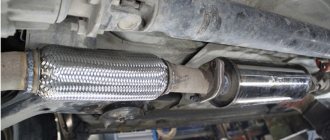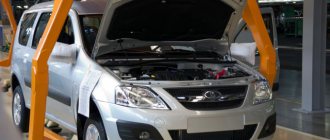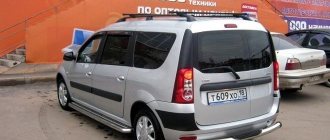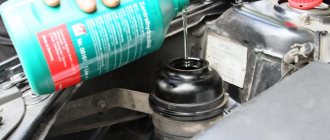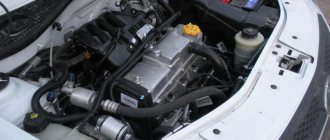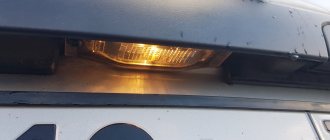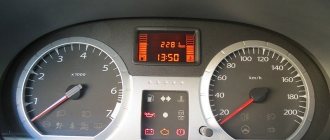One way to squeeze a little more driving fun out of your car is to seek chip tuning services. They say that flashing the electronic engine control unit (ECU) makes the car more dynamic, reduces acceleration time to 100 km/h, makes the accelerator pedal more responsive, etc. Feature of Vesta and XRAY.
The plant installs the same 1.6-liter VAZ 21129 and 1.8-liter VAZ 21179 engines in Lada Vesta, Vesta SW, Vesta cross and XRAY cars, so it was decided to combine the reviews in one article.
Earlier, one of the masters of his craft answered all the basic questions about engine firmware.
Chip tuning is usually completed within 20 minutes:
- The master is connected to the ECU connector in the engine compartment (in the passenger compartment, the OBD-II connector is not suitable for this; there is no registration protocol).
- Reads the standard program (so that everything can be returned if necessary).
- Compile a modified version of the program.
The approximate price of chip tuning is 2500 rubles. Let's see if this engine tuning is worth the money?
RSW. One of the first reviews about Vesta chip tuning appeared in the summer. In it, the author states that after updating the “brains,” Vesta began to accelerate to hundreds almost 2 seconds faster (the time decreased from 16.2 seconds to 14.4). According to him, chip tuning changed the response of the accelerator pedal and slightly loosened the clamp of the stabilization system (it became possible to start with a slight slip). At the end of the video review, he shares his impressions of chip tuning:
- the accelerator pedal reacts more sharply to movement, there is no delay when you need to accelerate;
- when driving, the stabilization system works much later.
Bottom line: Chip tuning is worth the money. You shouldn't expect a miracle, but you will definitely get a little pleasure.
Another review appeared soon after. The Vesta owner first took readings using Racelogic in the standard configuration, and then loaded the RSW firmware. I took the values using the same software and compared the two graphs.
The only change that was noticed is that the throttle valve opens completely, somewhere in the middle of the stroke, there is no point in pressing further, nothing changes. In other words, only the accelerator pedal was stitched.
Icebreaker. In a similar way (using Racelogic), a comparison was made between the standard and modified versions of the ECU program. According to estimates, Vesta first accelerated to 100 km/h in 219.45 meters, and after tuning the chip, the car traveled 229.47 meters in the same time. If you imagine this visually, the chip machine was two bodies ahead. It was also noted that in first gear the engine can be “scranked” to 7000 rpm and above.
There are also firmwares for the Vesta engine with the names “Paulus” and “Adakt”. Reviews about them will be added over time.
Do you think it is possible to achieve a significant increase in power by tuning the microcircuit, or is there no point in flashing a naturally aspirated engine? Leave your feedback about Vesta / XRAY chip tuning in the comments. Let's remember that we previously looked at the optimization of Grant, Kalina and Priora microcircuits.
- Engines
- Ns
- 21129
The 1.6-liter 16-valve VAZ 21129 engine was first introduced only in 2015 and is essentially an adaptation of the 21127 unit to the stringent environmental requirements of EURO 5. This engine was created for the Lada Vesta and X-ray models, and has been installed on Largus since 2022 of the year.
The VAZ 16V line also includes: 11194, 21124, 21126, 21127, 21128 and 21179.
- Characteristics
- Description
- Consumption
- Application
- Reviews
- Service
- Break up
- Prices
How to increase the power of an internal combustion engine
In general, the power of the power unit can be increased by:
However, currently there is so-called chip-tuning (chip-tunning, from English microcircuit tuning) - a technique for increasing power that does not require changes to the design of car engines. The use of chip tuning makes it possible to optimize or improve the performance characteristics of any car, including the LADA Largus family station wagon, which has been produced by AvtoVAZ OJSC since 2012, without resorting to changing the engine design.
Results of service provision
After completing the professional tuning of the Lada Largus, you will notice the following points about your car:
- increase in maximum driving speed;
- reducing the time required to overtake;
- optimization of vehicle acceleration dynamics;
- disappearance of power dips at different speeds.
Entrust chip tuning of Lada Largus in Moscow to Chipmaster specialists. We have extensive experience and provide a long guarantee for the service!
Power units of the LADA Largus car
The LADA Largus and LADA Largus Cross cars are developed on the basis of the popular Renault (Dacia) Logan MCV station wagon and differ from the prototype in the suspension adapted for domestic roads. They are equipped with gasoline 4-cylinder French power units with a cylinder capacity of 1.6 liters:
In addition, the LADA Largus is equipped with a 1.6-liter VAZ-11189 engine with a power of 87 hp. pp., which is a VAZ-11186 engine adapted to EURO-5 requirements.
Long-term operation of the LADA Largus and LADA Kross station wagons has shown that all the engines they are equipped with are somewhat weak. At the same time, the use of traditional methods of functional (mechanical) tuning, which boil down to making changes to the design of power units, does not produce significant results. The easiest way to eliminate this drawback without changing their design is to use modern chip tuning technologies.
About the domestic VAZ 11189 engine
In April 2022, AvtoVAZ began installing domestic VAZ 11189 engines on Largus. The advantages of this engine are described in one of the issues of “Okay Mechanics”.
| Some measurement results Autoreview | |||
| Options | Cars | ||
| Lada Largus (VAZ engine) | Lada Largus (Renault engine) | ||
| Maximum speed, km/h | 157,1/156,7* | 168,0/167,6 | |
| Acceleration time, s | 0—50 km/h | 4,3/4,8 | 3,9/4,4 |
| 0—100 km/h | 13,9/16,8 | 12,5/14,5 | |
| 0—150 km/h | 61,1/71,6 | 38,9/43,7 | |
| on the way 400 m | 19,3/20,2 | 18,4/19,4 | |
| on the way 1000 m | 36,1/37,8 | 34,1/36,0 | |
| 60-100 km/h (III) | 8,7/10,6 | 9,3/10,6 | |
| 60-100 km/h (IV) | 12,1/15,1 | 12,8/14,1 | |
| 80-120 km/h (V) | 19,3/24,0 | 22,1/23,4 | |
| * Partial load/full load | |||
CHIP tuning of LADA-Largus engines
Improving the dynamic characteristics of LADA Largus power units using chip tuning is ensured by modifying and correcting factory settings in the program that directly controls the operation of the engine. Factory firmware is averagely balanced between such operational characteristics of a particular power unit as power, reliability and environmental friendliness. Unfortunately, they do not always provide optimal engine operating conditions under various operating conditions of the vehicle. You can change the factory settings of the engine electronic control unit (ECU) using special equipment and professional software (chip tuning).
Today, chip tuning of LADA Largus car engines can be carried out in two ways (the type of engine does not matter significantly):
Flashing the ECU
The factory firmware of the ECU is a set of two or three-dimensional tables (maps), which are connected by a certain sequence and stored in a chip (integrated circuit). The number of these cards and the data contained in them depend on the specific engine type. Access to them is possible only with the help of a special programmer and professional software. To connect the equipment, a special OBD diagnostic connector (port) is used, which is located in the vehicle interior. There is no need to dismantle the ECU.
High-quality chip tuning on the LADA Largus can only be done on a working engine. Diagnosis of the latter's ECU is carried out before specialists begin work. Their comments must be eliminated, otherwise the entire chipping procedure will not make sense.
Reflashing the factory settings of the ECU is carried out step by step in a certain order:
This completes the flashing process. During the chipping process, new firmware is introduced into the ECU, which changes the modes:
Chip tuning of the factory ECU settings increases engine power and torque by approximately 10%.
Installation of chip tuning boxes
Currently, this type of chip tuning is in great demand, such as installing an original power module (chip tuning box). Installation and proper configuration allows you to increase both the torque and power parameters of the motors. In addition, the stability of the power unit increases:
The chip tuning box is installed under the hood of the car and is connected to the engine through the sensors and connectors available on it. For this purpose, a multi-channel cable is included in the package.
Structurally, the chip tuning box is a body made of impact-resistant fiberglass reinforced with a metal lid.
The operating principle of the chip tuning box is to adjust control signals outside the ECU. The most important element of the device is a printed circuit board with electronic components installed on it. Its operation is controlled by a microprocessor, which does the main work of improving the dynamic characteristics of the engine. The main advantage of the chip tuning box when installing it on LADA Largus is the adjustment of control cards without changing the standard ECU software. In this case, no changes are made to the design of the power unit or ECU. At the same time, the car owner is given the opportunity to independently adjust the output power parameters, which are displayed on the LED panel of the unit.
The chip tuning box is as easy to dismantle as it is to install. In this case, all factory settings are restored independently.
Installing a chip tuning box on LADA Largus allows you to:
Source
What will you get out of it, do it or not?
A serviceable car, after reprogramming and under all equal operating conditions, will have:
- Better acceleration dynamics.
- It will become more “high-torque” with less pressure on the accelerator pedal - engine torque will increase and shift to lower speeds, and the maximum speed will increase.
- Elasticity will improve, i.e. When driving, you will have to switch to lower gears less.
- The engine will run more smoothly.
- Fuel consumption will decrease (with a normal, calm driving style).
Does Lada Largus need additional anti-corrosion treatment?
The first of the two engines is equipped with 16 valves, and it became the basis for all trim levels of the crossover station wagon. It is this, and not the 8-valve K7M, although 8-valve internal combustion engines are more suitable for the SUV segment. In fact, the K7M engine is inferior to its 16-valve brother in both power and traction characteristics. And if the Lada Largus Cross engine had been 8-valve, neither the factory nor the buyer would have benefited from this. Let's look at the details.
The following video lists tips that are relevant for every owner of a Largus crossover.
How much will be added?
By the way, what moves the car forward is not power, but TORQUE - the product of force and the arm of the lever to which it is applied. To be brief, it is the amount of torque that is important for accelerating a car, and the better it will accelerate, the greater the torque for the required engine speed. Power is a derivative of torque, and the higher it is in the end, the faster the car will be. In other words, for a car to accelerate quickly and be flexible, torque is needed, and for it to drive quickly, power is needed. So, I repeat, after programming, the torque increases and shifts to the region of lower speeds and at the same time, as a derivative of the torque, the power increases accordingly. In the end - in good working order! The car will have lower fuel consumption with increased torque and power. It will be more pleasant to operate the car, at lower costs. I think everyone strives for this.
And so, after pre-programming we get:
- on naturally aspirated engines, torque and power increase by 8-10%.
- on turbocharged engines, the increase in torque can reach 40% and power by 35%.
If your car with a naturally aspirated engine has a passport rating of 100 hp. and 140 Nm of torque, then after programming the car will have 110 hp. and 154Nm respectively. If the engine is turbocharged and has the same 150 hp. and 210 Nm, after reprogramming it will be about 190 hp. and 270 Nm.
What is the difference between the 1.6 16 valve engine Lada Largus 21129 and 21127?
Firstly, the 21129 engine is a modified version of the 21127, which differs primarily in toxicity standards. 21129 is adjusted to EURO-5 toxicity standards in order to obtain approval under current legislation.
Secondly, the compression ratio has been changed. 21129 the engine was literally “unclamped” to make it possible to use AI-92 class fuel. The 127 engine did not have this option.
Thirdly, the 129 1.6 Lada Largus engine with 16 valves has a modified intake and exhaust, which has a positive effect on the dynamics of the car.
Fourthly, the 129 motor runs under a new engine control unit with a modified program.
Fifth, the engine mounts have been modified to reduce vibration from the powertrain.
And this is just a small part of the changes that affected engine 21129. In fact, there were much more, but alas, many, seeing that the engine is similar in appearance, think that no changes were made. If we dig deeper, we will see that the piston rings have become thinner and the piston has become lighter. This was done to reduce friction and increase engine life, as well as improve the overall performance of the engine.
What is chip tuning
The phrase “chip tuning” is formed from two words: “chip” - microcircuit, and “tuning” - improvement. The essence of the process is to change the engine control algorithms of the electronic unit to achieve better results - finalizing the factory characteristics. The ECU operates according to a specific program, which is stored in a ROM type memory (read-only memory), in accordance with various calibration tables (two- or three-dimensional). There are calibrations for different engine operating modes - starting, idling, power - and are used depending on how exactly the engine operates at a particular moment. Sensors transmit data to the controller, and it issues commands to the executive units, ensuring and maintaining stable engine operation. When adjustments are made to the calibration tables, the operating algorithm of any unit controlled by the ECU changes.
To increase power, you can change the ignition timing, fuel injection time, and the operating mode of the catalyst responsible for the toxicity of exhaust gases. You can also increase the maximum speed and many other parameters.
Chip tuning is firmware that improves the functionality of a car. It allows you to install additional electronic modules, including replacing the standard ECU with a modernized one, followed by adjusting the operating parameters of the power plant. In most cases, chip tuning involves manipulation of the factory controller.
Advantages
The Largus engine has a reserve of power and does not work at full capacity. Controller firmware will help:
Such tuning is simpler than a deep modernization of the engine - installing a turbine or boosting it. Installing the firmware takes no more than an hour, while the work listed above can take a week or more. Among the advantages of such modernization:
The settings are selected according to your driving style - from economical to aggressive. Combined software has become in demand, with the help of which maximum results can be achieved from the engine.
After the firmware, there is a general improvement in performance and an increase in performance relative to the standard version by about 20%.
Flaws
Chip tuning has fewer disadvantages than advantages, but each of them can “discourage” the desire of car enthusiasts to flash the ECU. Negative aspects of the procedure:
These shortcomings may discourage those wishing to improve the parameters of the Lada Largus engine. If you approach the matter competently and find good specialists, then the risk of “killing” the motor is minimal.
Engine firmware, great review from the master
What does the firmware of the engine control unit (ECU) affect? If I replace the factory firmware, what are the pros and cons? Which firmware is better? These and other questions were answered on the Lada.Online website by a specialist who has been involved in chip tuning of cars, including LADA models, for about 15 years.
Stanislav Polyakov began to work on engine firmware since the days of the VAZ 2114, Prior and Kalin cars. For more than 10 years he has been working in a specialized center for repairing Mercedes-Benz commercial vehicles. Engaged in repairs and flashing of Mercedes-Benz trucks and Sprinter vans. Now he is actively involved in chip tuning of modern Lada Vesta, Lada XRAY and Lada Granta cars. Total experience working with firmware is more than 15 years.
Question
: What does engine firmware provide or, as they say, the “brains” of a car?
Answer
: Chip tuning allows you to reveal the potential of the engine more fully. In this case, ecology fades into the background, and in the first place are the power characteristics, which make it possible to achieve better torque, elasticity, power, etc. Also, firmware can solve the problem of long engine startup, change the temperature at which the fan turns on, solve problems with jerking when shifting gears, familiar to many Vestavods, problems with the immobilizer, etc.
Question
: Really, I can’t make normal firmware at the factory?
Answer
: At the factory, engineers make firmware that must meet toxicity standards. Therefore, the factory firmware suffocates the engine for the environment.
Question
: Where did the firmware names of MMK, Chelyaba, Icebreaker, Paulus, RSW, etc. come from?
Answer
: Tuning authors take factory firmware and make their own based on it, calling it according to their brand.
Question
: Does the engine power change after the firmware?
Answer
: Power after engine firmware is most often not measured, and even if it is measured, the test bench readings are not an indicator of the quality of the firmware. A car with firmware can drive much better than a factory one, the pedal will be more responsive, it will respond faster to the gas, it will accelerate faster, but the power may remain approximately the same or slightly more than the factory one (as for naturally aspirated engines).
There are firmwares that show amazing results on a dyno, but in fact the car doesn’t drive at all. The car just jerks and detonates, it is impossible to drive with such firmware. In my practice, many people bought such firmware and then gave up. I have it too, I tried to install it, the car doesn’t drive on it at all, it sometimes breaks out from under itself, or on the contrary, power loss begins. Therefore, measuring power after flashing the engine is not entirely correct; the stand measures power within one gear and with the pedal constantly pressed to the floor, but in life we don’t drive like that.
Question
: Does firmware affect engine life?
Answer
: In general, no, but if it is unsuccessful and the car detonates on it, then of course this will greatly reduce the service life, or even kill the engine.
Question
: Will fuel consumption change after the firmware?
Answer
: Consumption depends on the author of the firmware and the driver’s driving style. For most, consumption decreases.
Question
: Which firmware is better to choose? What advice can you give?
Answer
: For those who do not have an aggressive driving style and who want to get rid of dips when switching, who want to get an adequate gas pedal, but will not drive like crazy, this is how I upload firmware from MMK. These are very balanced firmwares, the golden mean between smoothness and dynamics. It doesn’t happen that after flashing the car the car drives like crazy, and at the same time it would be smooth. That is, these are things that are incompatible with each other.
MMK Super Dynamic is available for 1.6 engines with manual transmission. It allows you to get maximum dynamics from the car. Firmwares are suitable for those who like to drive. These firmwares have amazing traction, the car drives very well, but the transition from engine braking to acceleration mode is very abrupt. If you upload this firmware to someone who doesn’t like to drive, there will often be complaints about a very harsh pedal, and the ride becomes uncomfortable.
Recently I have been uploading firmware from Chelyaba to 1.6 engines with AMT (“robot”). He made firmware for Vesta with creeping mode. At the factory, 1.6-liter engines are not equipped with creep mode firmware, because the engine does not know how to accelerate. This was done at the software level, and as I understand it, they don’t want to pay money for the development of completely new software for 1.6 engines, so they decided to leave these engines without creep mode. And in the Chelyab firmware the idle speed has been slightly added to make it easier to get underway. And when the clutch is released, the “robot” accelerates a little. The car with this firmware drives very cheerfully.
Engine Lada Largus 1.6 16 valves - technical characteristics
| Manufacturer | AvtoVAZ |
| ICE index | 21129 |
| Years of manufacture | 2015–present |
| Volume, cm3 (l) | 1597 cm3 (1.6 l) |
| Power (hp) | 78 kW (106 hp) |
| Torque Nm (rpm) | 148 Nm (at 5800 rpm) |
| Weight, kg | 110 kg |
| Compression ratio | 10,5 |
| Nutrition | injector |
| Motor type | in-line |
| Injection | distributed electronically controlled |
| Ignition | coil for each spark plug |
| Number of cylinders | 4 |
| Number of valves | 16 |
| Cylinder head material | aluminum alloy |
| Cylinder block material | cast iron |
| Cylinder diameter | 82 mm |
| Piston stroke | 75.6 mm |
| Fuel | AI-92/AI-95 |
| Environmental standards | EURO-5 |
| Fuel consumption | highway – 5.3 l per 100 km |
| combined cycle 6.6 l per 100 km | |
| city – 9 l per 100 km | |
| Oil consumption | maximum 0.1 l/1000 km |
| Motor life | stated 200,000 km |
| real 300000 km | |
| Adjustment of valves | hydraulic compensators |
Foreign analogue
The original model of this car is the French development of Dacia Logan MCP. It is produced at factories in Romania. This is a station wagon car and belongs to the “B” class of cars. Now it is one of the most popular family cars in Western Europe. The appearance and technical characteristics of the Lada Largus are very similar, but there are also significant differences. First of all, this is the radiator grille, which makes the design of the Russian vehicle more stylish and fashionable.
Dacia Logan MCV - one might say, this is the father of our Lada Largus
Disadvantages of the Lada Largus 1.6 16 valve engine
1. The first and most unpleasant drawback that the 1.6 engine from Lada Largus has is increased oil consumption. Although, according to the manufacturer’s stated data, the maximum oil consumption should not exceed 100 ml per 1000 km, in fact this figure can be 2.5 times higher. Of course, this problem will not affect many at all, but for many it will be an unpleasant surprise. However, you should not immediately run to a car service center and ask to have the engine rebuilt due to increased consumption. You may simply have chosen the wrong engine oil.
2. The second significant drawback is the bending of the valves when the timing belt breaks . Yes, engine 21129 bends the valve when the timing belt breaks. Unfortunately, nothing can be done about this problem. There is only one way out - timely change the timing belt and rollers and monitor their condition.
3. The third drawback is the knocking of the hydraulic compensators. Since valve clearance is regulated by hydraulic compensators, they tend to knock. This can occur both on a cold engine and on a hot one. Most often, this problem is caused by low-quality engine oil or its untimely replacement. But this drawback exists and does exist.
Service cost
Moscow and region
The service is provided on site or at the address: village. Fork, 2a . The village is located outside the Moscow Ring Road along Kashirskoye Highway opposite the state farm named after. Lenin. See further down the site for the service provision period.
Ask questions to the master by phone: 8-965-321-31-01 (Beeline Moscow).
Or write to the master by e-mail:
Or use the feedback form in the lower right corner. * Write your cell phone number directly in the message. Sometimes the answer doesn’t reach you!
St. Petersburg and region
The service is usually provided on site in your territory. Description of the terms of service further down the site.
Or use the feedback form in the lower right corner. * Write your cell phone number directly in the message. Sometimes the answer doesn’t reach you!
Cheboksary
See further on the site for the provision of services in Cheboksary
You can ask him questions by phone: 8-965-321-31-01 (Beeline Moscow) 8-965-070-65-01 (Beeline Peter) WhatsApp. I can call you back from this number.
Or write to the master by e-mail:
Or use the feedback form in the lower right corner. Please include your cell phone number in your message.
Nizhny Novgorod
See further on the site for the provision of services in Nizhny Novgorod
You can ask him questions by phone: 8-965-321-31-01 (Beeline Moscow) 8-965-070-65-01 (Beeline Peter) WhatsApp. I can call you back from this number.
Or write to the master by e-mail:
Or use the feedback form in the lower right corner. Please include your cell phone number in your message.
Naberezhnye Chelny
In Naberezhnye Chelny, the service will be provided upon arrival in the city. See the schedule further down the site.
You can ask questions by phone: 8-987-406-77-07 (MTS Nab. Chelny) 8-937-57-11-007 (Megafon Nab. Chelny)
Or write to the master by e-mail:
Or use the feedback form in the lower right corner. * Write your cell phone number directly in the message. Sometimes the answer doesn’t reach you!
Ekaterinburg
See further on the site for the provision of services in Yekaterinburg The place of stay will be Pervouralsk.
You can ask questions or leave a request using feedback by e-mail:
or by phone: 8-965-070-65-01 (Beeline Peter) WhatsApp. I can call you back from this number. Or use the feedback form in the lower right corner.
Chelyabinsk
See further on the site for the provision of services in Chelyabinsk
You can ask him questions by phone: 8-965-321-31-01 (Beeline Moscow) 8-965-070-65-01 (Beeline Peter) WhatsApp. I can call you back from this number.
Or write to the master by e-mail:
Or use the feedback form in the lower right corner.
See further on the site for the provision of services in Ufa
You can ask him questions by phone: 8-965-321-31-01 (Beeline Moscow) 8-965-070-65-01 (Beeline Peter) WhatsApp. I can call you back from this number.
Or write to the master by e-mail:
Or use the feedback form in the lower right corner.
Chip tuning in a car service
The chip tuning process in specialized organizations looks approximately the same. The car owner comes to the service center, where, using special equipment, the factory firmware is read from the control unit. It is then modified depending on the client’s wishes - to reduce fuel consumption, increase power, remove the speed limit. After this, the ECU is flashed with a modified program.
Often, such services already have a set of programs for different cars - in this case, the duration of the procedure is reduced. After installing the new software, the warranty period begins, during which you need to run the car in. During this time, the client may demand to correct one or another parameter that made the operation worse, or to return the money for “chipping” if the result is not satisfactory. In this case, the service is obliged to “roll back” the firmware to its factory state.
Program tuning is one of the most difficult chip tuning procedures. The complexity depends on the wishes of the driver and the system that controls the engine. Tuning consists of making changes to the existing calibrations, after which checksums are calculated. If there are already similar calibrations in the database, they will be exported to the program. These procedures are carried out without the participation of the car owner. On average, chip tuning of a Lada Largus will cost about 4-5 thousand rubles.
Where do the savings come from?
A four-cylinder engine makes four strokes in one full cycle. On the first stroke, fuel is always supplied. A modified throttle makes the fuel mixture better. Due to which it burns better. Because of this, the engine torque increases. And the car becomes more dynamic at low speeds. After a short dynamic acceleration, switch to a higher gear. Due to this, the speed is reduced. And the number of first measures decreases. That is, less fuel is supplied. On some cars, the ECU also reduces the amount of fuel supplied.
Selection of engine oil for the Lada Largus engine 16 valves 1.6 l.
Probably one of the most pressing topics on forums is the choice of lubricants for engines. So that no one says that we are advertising and promoting motor oils here, I will not indicate specific brands of motor oils in the article, but will only provide recommendations from AvtoVAZ.
The manufacturer recommends using motor oils with viscosity in the 1.6 Lada Largus 1.6 engine:
5W-30 / 5W-40 / 10W-40 / 15W-40.
Oils with a viscosity of 5W30 and 5W40 are ideal for use in cold regions, such as Siberia, while oils of 10W-40 and 15W-40 are only suitable for use in the warm season or in hot climates. At low negative temperatures, the starter may not “crank” oil that is too thick. And if it turns, there is a high risk of the seals being squeezed out by the thickened lubricant.
But there is also a recommendation for using 0W-40 oil. This viscosity is suitable for those who have bought a new car or use it in the coldest regions. Viscosity 0W-40 provides excellent fluidity and lubrication of rubbing parts at any low temperatures.
But it is not enough to select oil based on viscosity alone, as there are other criteria. First, you need to understand that there are oils for gasoline or diesel engines, as well as universal ones. In our case, we need to focus either on gasoline oils or universal ones. These oils are designated by the letter S according to the API. For example, API SL or SN are oils for gasoline engines. But API SN/CF is a universal option, suitable for both gasoline and diesel.
AvtoVAZ recommends using engine oils according to API no lower than SM and ILSAC no lower than GF-4. You can also use oils of a class higher than those recommended.
External speed characteristics of the 1.6 Lada Largus engine compared to the engine from the Lada Vesta - 21179.
Below is a graph of the power and torque of engines 21129 and 21179 and maximum power. The graph clearly shows that engine 21129 produces a maximum torque of 148 Nm at 4200 rpm. And at 5800 rpm we see a maximum power of 78 kW. Of course, these figures do not reach the 21179 engine, but it is felt that AvtoVAZ did a good job of tuning and modernizing the engine.
Improved engine starting
The engine starting stage is quite energy-intensive. Therefore, the manufacturer in the factory program makes it as environmentally friendly as possible and reduces emissions of harmful substances. This makes starting the engine much more difficult.
We believe that the engine should start easily, quickly and without any problems.
Many cars have difficulty starting in the cold season, especially after being idle. This is explained by the “eco-friendly” ECU settings. We change the parameters, and the problems with starting the engine go away.
The package contains versions for E2 , which is unlikely to be found anywhere, and also a version with a close to optimal OZ for working on propane - butane mixtures.
Startpower - tuning firmware. S110140026A_8201264017 - firmware identifier E2 - Euro 2 toxicity standards. 95_ - for gasoline with an octane rating of at least 95. GBO santehnika - for third generation gas equipment. GBO4 - for fourth generation gas equipment.
Download manuals for working with the ECU.
Firmware for 1 identifier - 300 rub. . If you want to purchase individual firmware from the LADA Largus package with EMS3132 ECU from Paulus and Icebreaker, place an order, select a payment method, and in the comments indicate which firmware YOU need.
Buy a set of firmware for LADA Largus with EMS3132 ECU from Paulus and Icebreaker (specify the required firmware identifier and amount)
When paying, payment processing takes place on the website of the electronic payment system, which has passed international certification. This means that your confidential data (card details, registration data, etc.) are not sent to the online store, their processing is completely protected and no one can obtain the client’s personal and banking data
Download a set of firmware for LADA Largus with EMS3132 ECU from Paulus and Icebreaker
Список прошивок пакета: LADA Largus Paulus 1.6L 16V — CombiLoader S110140026A_8201264666.bin StartPower_S110140026A_8201264666.bin StartPower_S110140026A_8201264666_E2.bin StartPower_GBO4_S110140026A_8201264666_E2.bin StartPower_GBOsantehnika_S110140026A_8201264666_E0.bin LADA Largus Paulus 1.6L 8V — CombiLoader S110140026A_8201261286.bin StartPower_92_S110140026A_8201261286.bin StartPower_92_S110140026A_8201261286_E2.bin StartPower_95_S110140026A_8201261286.bin StartPower_95_S110140026A_8201261286_E2.bin StartPower_GBO4_95_S110140026A_8201261286_E2.bin StartPower_GBOsantehnika_95_S110140026A_8201261286_E0.bin 112012 S110140026A_8201264017_45E045004D31.bin StartPower_92_S110140026A_8201264017_45E045004D31.bin StartPower_92_S110140026A_8201264017_45E045004D31_E2.bin StartPower_95_S110140026A_8201264017_45E045004D31.bin StartPower_95_S110140026A_8201264017_45E045004D31_E2.bin StartPower_GBO4_95_S110140026A_8201264017_45E045004D31_E2.bin StartPower_GBOsantehnika_95_S110140026A_8201264017_45E045004D31_E0.bin LADA Largus Paulus 1.6L 16V — CalibOnly — только калибровки (Galleto) S110140026A_8201264666_Calib.bin StartPower_S110140026A_8201264666_Calib.bin StartPower_S110140026A_8201264666_E2_Calib. bin StartPower_GBO4_S110140026A_8201264666_E2_Calib.bin StartPower_GBOsantehnika_S110140026A_8201264666_E0_Calib.bin LADA Largus Paulus 1.6L 8V — CalibOnly — только калибровки (Galleto) S110140026A_8201261286_Calib.bin StartPower_92_S110140026A_8201261286_Calib.bin StartPower_92_S110140026A_8201261286_E2_Calib.bin StartPower_95_S110140026A_8201261286_Calib.bin StartPower_95_S110140026A_8201261286_E2_Calib.bin StartPower_GBO4_95_S110140026A_8201261286_E2_Calib.bin StartPower_GBOsantehnika_95_S110140026A_8201261286_E0_Calib.bin 112012 S110140026A_8201264017_45E045004D31_Calib.bin StartPower_92_S110140026A_8201264017_45E045004D31_Calib.bin StartPower_92_S110140026A_8201264017_45E045004D31_E2_Calib .bin StartPower_95_S110140026A_8201264017_45E045004D31_Calib.bin StartPower_95_S110140026A_8201264017_45E045004D31_E2_Calib.bin StartPower_GBO4_95_S110140026A _8201264017_45E045004D31_E2_Calib.bin StartPower_GBOsantehnika_95_S110140026A_8201264017_45E045004D31_E0_Calib.bin
Calibrations: Paulus © Paulus
Startpower - tuning firmware. S110140026A_8201264017 - firmware identifier E2 - Euro 2 toxicity standards. 95_ - for gasoline with an octane rating of at least 95. GBO santehnika - for third generation gas equipment. GBO4 - for fourth generation gas equipment.
LEDAKOL LARGUS 1.6l 16cl
CombiLoader LARGUS 1.6_16V_е2.bin LARGUS 1.6_16V_е4.bin LPG - LARGUS 1.6_16V_е0.bin
Galleto LARGUS 1.6_16V_е2.bin LARGUS 1.6_16V_е4.bin HBO - LARGUS 1.6_16V_е0.bin
S110140026A S110140026A_8201264666 S110140026A_8201264666.bin S110140026A_8201264666_E-2.bin S110140026A_8201264666_E-4.bin S110140026A _8201474331 S110140026A_8201474331.bin S110140026A_8201474331_E-2.bin S110140026A_8201474331_E-4.bin
LARGUS 1.6l 8kl
CombiLoader LARGUS 1.6_8V_е2.bin LARGUS 1.6_8V_е4.bin LARGUS 1.6_8V_е0.bin Galleto LARGUS 1.6_8V_е2.bin LARGUS 1.6_8V_е4.bin LARGUS 1.6_8V_е0.bin
S110140026A S110140026A_8201261286 S110140026A_8201261286.bin S110140026A_8201261286_Е-2.bin S110140026A_8201261286_Е-4.bin S110140026A_8201264017 S110140026A_8201264017.bin S110140026A_8201264017_Е-2.bin S110140026A_8201264017_Е-4.bin S110140026A_8201264021 S110140026A_8201264021.bin S110140026A_8201264021_Е-2.bin S110140026A_8201264021_Е-4.bin
Dynamic versions with consumption lower than factory. Improved launch.
Options e4 and e2. Each firmware is in version e0 for use with 3rd generation HBO. https://www.auto-bk.ru/forum/ https://motor-chip.ru/forum/
Calibrations: Icebreaker © ledokol
Further processing
There is not much experience in using the Lada Largus in Russian conditions, since the model is relatively new. However, when considering the reliability of a car, you can rely on reviews from owners of the Renault Logan MCV, which served as the basis for the creation of the VAZ station wagon. Moscow taxi drivers, who often use such a car, point to the high quality of painting and galvanizing of the bodies - corrosion can spread above thresholds only in case of serious damage. However, you need to pay special attention to the sills themselves and the bottom of the car.
The accumulated experience in operating the Lada Largus will also come in handy - after the first Russian winter with severe frosts and subsequent prolonged thaw, anti-corrosion treatment may lose its effectiveness. The space inside the wheel arches, as well as the sills and the area immediately behind the front bumper are particularly at risk. After prolonged “bombardment” of stones and dust, supplemented by exposure to moisture and deicing agents, the protective coating may be damaged. Therefore, experts recommend repeated anti-corrosion treatment of the Lada Largus after the first severe winter or after a year of active use.
There is an opinion that after the first season of operation the body needs to be re-treated
Corrosion throughout the Lada Largus is very rare due to high-quality factory processing. However, many station wagon owners complain about brown spots that cover the underside of the sills and some areas of the underbody. Rust stains can be prevented by performing additional anti-corrosion treatments every two years after the first. This measure will help ensure the reliability of the car even in the most severe operating conditions.
Source

